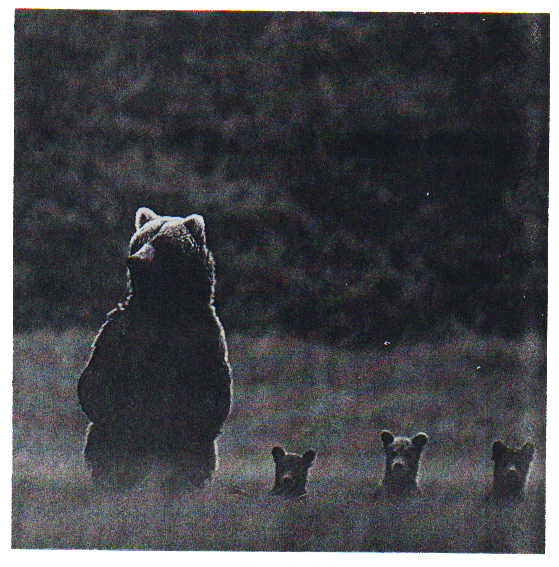 This collection of student work is from Frank Keim's classes. He wants to share these works for others to use as an example of culturally-based curriculum and documentation. These documents have been OCR-scanned and are available for educational use only.
This collection of student work is from Frank Keim's classes. He wants to share these works for others to use as an example of culturally-based curriculum and documentation. These documents have been OCR-scanned and are available for educational use only.Special | A | B | C | D | E | F | G | H | I | J | K | L | M | N | O
P | Q | R | S | T | U | V | W | X | Y | Z | ALL
The Brown Bear by Gabriel Duny:
Alaska Brown Bear
The Brown Bear The Alaskan Brown bear, Ursus arctos middendorfi , is the largest meat eating land mammal and the largest bear in Alaska. These bears may exceed nine and a half feet. The largest bear taken was in 1969. It measured 10 1/2 feet long and weighed nearly 1,800 pounds. The Brown bear stands 4-4 1/2 feet high on all fours. A hump quite large and noticeable rests on the bear's shoulders. The size and color of the Brown bear depends upon the geographic location, its age, sex and the time of the year. The coastal bears are three times larger than the interior bears. The quality and amount of food have a large impact on the size of the bear. The interior Brown bears have a darker color than the coastal bears. The age of Brown bears is determined by the stained rings on their teeth. The oldest bear taken from the wilderness was a 36 year old boar. There was once a 47 year old female in a zoo. The Brown bear is found throughout southern Alaska and in parts of southeastern Alaska. There are also a few Brown bears left in Asia. Density levels are higher in the Aleutian Islands, Panhandle, on the Kodiak Island and southcentral Alaska. The bears we have here in Marshall are smaller Brown bears known as Grizzly bears. The lowest number occur in northern Alaska and the Arctic regions. The Brown bear's diet consists of many foods. It digs up small rodents with its claws and searches for ants, shrubs and other insects in the same way. The Brown bear eats a wide variety of plants and berries, fruits that are available, sedges, horsetails, and salmon which is a very important supplement in the bear's diet. The berries are eaten by the gallon and the animals are eaten whenever possible. The Brown bear is not a finicky eater. Once a biologist saw a boar chase and eat a cub when its mother wasn't looking. The McNeil River is one of the most popular sites for the Brown bear to fish for salmon. The bears usually eat the eggs and leave the carcass for the seagulls and the immature male brownies. The bears do not catch that much fish in a day. A biologist surveyed the catches and found that they catch about three fish an hour. About 10-12 bears are common when they are fishing. During some years, as many as 65-70 bears may be seen fishing on the McNeil River. Brown bears are attracted to dumpsites in many villages or cities. People also give the bears handouts that aren't healthy and nutritious. By the time they are ready to hibernate, they have not gained enough fat for the hibernation period. These bears take at least a month to gain the weight back to get ready for hibernation. Dumpsites and the handouts given by people also cause Brown bears to lose their fear of man. A protein rich diet supplies the nutrients for the bears to gain the fat needed. Salmon is one of the major supplements for coastal bears. Protein rich diets also produce young, healthy cubs that are larger than the interior Brown bears. The coastal bears usually gain 40-50 pounds in one summer. The Brown bear seems most comfortable on the tundra or in grassy flats. When the bears come out of hibernation, they are commonly found in these areas, feeding on mainly grass and other fresh vegetation. During hibernation the 8-10 ounce hairless cubs are born around late January and throughout February. The gestation period for the Brown bear is usually 7-9 months. Denning periods for the Brown bears depend upon their sex, age, and physical condition. The interior Browns, or "brownies", enter their dens around late October, whereas the coastal bears enter their dens in November and December. The dens of the Brown bears are located somewhere on mountain slopes, in empty hollow logs, on hillsides and underground. On Kodiak Island the dens are often lined with leaves and grass. Hunting Brown bears is considered dangerous. Wounded bears attack their enemies and are difficult to kill. Female bears may chase after their enemy to protect their cubs. Non-residents kill nearly 62% of the Brown bears killed in Alaska and use them as trophies. Thirty-eight percent of the bears are killed by Natives in Alaska. There are 24 control units in Alaska that record the number of bears killed annually. These units are located throughout Alaska. The number of Brown bears is stable in most areas. There is no accurate number of bears in Alaska, but biologists say that there may be from 5,000-10,000.
Gabriel Duny Marshall School | |
|





